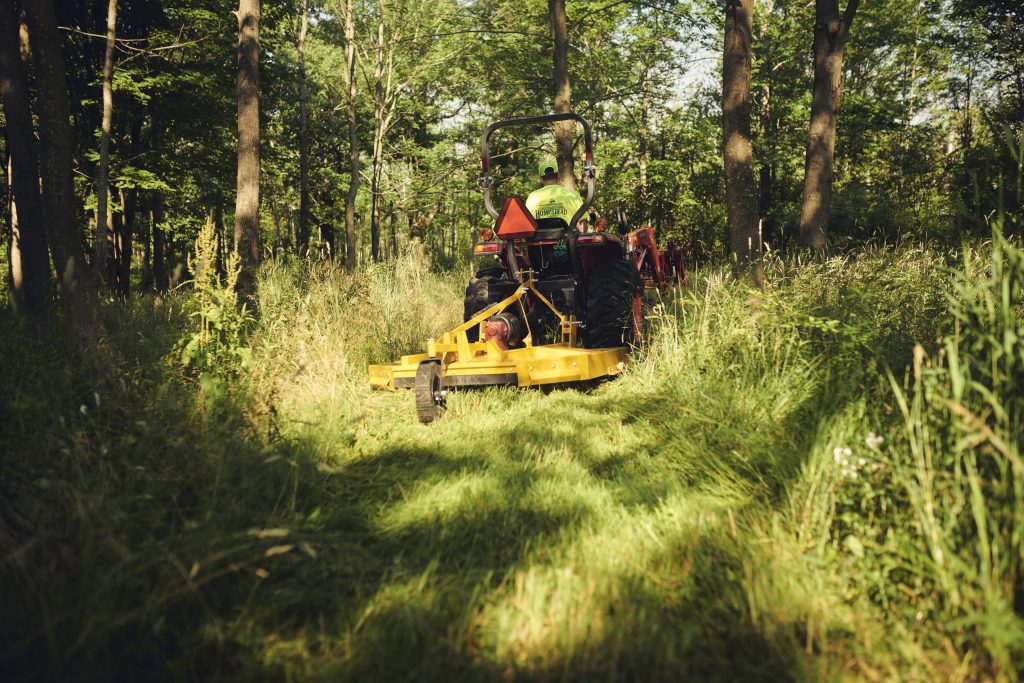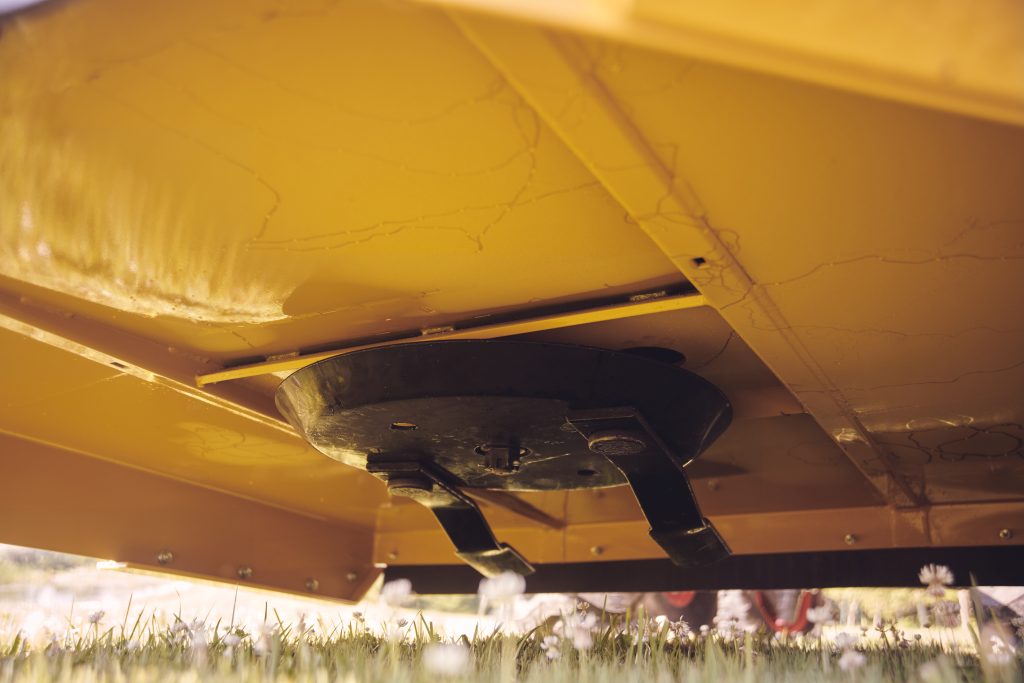Deer hunters and land managers oftentimes need a good tractor brush hog to keep the landscape at bay. While some landowners just want pretty landscapes, hunters have management practices in mind. That includes creating trails, clearing food plots, and more. But that isn’t possible without a good tractor brush hog. So, those who hope to achieve their land management goals must understand brush hogs for tractors and how they differentiate so that they can choose a model that will perform as they hope.
What Is A Tractor Brush Hog?
The basis of choosing a tractor brush hog starts with defining it. “A brush cutter is essentially a large lawn mower that you pull behind your tractor to cut larger brush,” said Travis Hoyt, agricultural sales manager for Homestead Implements. “This includes fields and things you might not do with a typical lawn mower, but the thicker stuff you wouldn’t want to damage smaller blades with.”
Tractor Brush Hog Options
As with most products, there are different offerings available to the public. Prospective buyers will find different types available to them. Some market options include:
- Weed-eaters
- Handheld
- Walk-behind
- Riding
- Four-wheeler pull-behind
- Tractor pull-behind
A land manager’s property size, land management goals, and other points, factor into what type of brush cutter to purchase. Each one offers different advantages, disadvantages, price points, and more. Choose what is best for the job at hand.
Tractor Brush Hog Parts To Pay Attention To
When assessing the quality of a tractor brush hog, it’s important to consider multiple factors. “It really depends on the three moving parts, which includes the PTO shaft, your gear box, and your blades. With heavier, thicker blades, you’re able to sling with more momentum. It’s easier to cut as well.

Additionally, a heavier gauge deck is helpful, too. “It depends on the materials the brush cutter is made out of,” Hoyt said. If you have a thicker deck on the top and sides of the brush cutter, it can take a little more. Also, the gearbox is going to have a big play in that as well. If you have a gearbox that’s weaker, and that can’t keep the blades spinning as they hit material, that plays into it as well. You have different gearboxes depending on how much horsepower your tractor might have.”
What Makes A Heavy-Duty Tractor Brush Hog?
Many landowners will need a heavy-duty brush hog tractor. They might have a larger acreage. Or, they might have a bigger job ahead of them. Regardless, a heavier brush cutter is needed to do the job properly and with less maintenance.
“It’s based on the size of the area you are brush-cutting,” Hoyt said. “If you are brush-cutting a large field, or a path through the woods, typically, hauling one behind a tractor is the best way to do it. You want something that’s heavier duty.” Take Homestead Implements’ Pinnacle Series, for example. “You can cut down saplings typically up to 2 inches,” Hoyt said. “It’s great for cutting back areas on your property, especially moving into new places where you have a section that’s overgrown. Just take into consideration what you’re cutting.”
What To Look For In Tractor Brush Hog Blades
One of the most important parts of the tractor brush hog is its blades. “With the blades, you typically want something that’s thicker,” Hoyt said. “It needs heat-treated, hardened alloy steel. For instance, ours are ½-inch thick and 3 inches wide. The length depends on how wide the brush cutter is. You want something at least ½-inch and wider to have weight behind it to cut through saplings and other brush.”

Anything smaller, or lesser, will have higher risks of damage. At the very least, these will likely require more regular maintenance work. To avoid that, invest in a larger, more durable brush cutter that incorporates better blades.
Assessing The PTO For Your Tractor Brush Hog
Anyone who’s ever used a tractor brush hog understands how important it is to be aware of the PTO shaft. This is obviously true for safety reasons. That said, it’s crucial for product longevity, too.
“The biggest thing with a PTO is that you want something that’s series four or higher,” Hoyt said. “For instance, we offer a series four or series six shaft. It just keeps spinning and working. We also offer slip-clutches on those. These are nice because it protects your gearbox from getting burned out. The other option is a shear pin, and the issue with these is when you are running and hit something it can’t cut and shears that pin, you must replace it. That takes time away from work.”
So, determine the gauge of the PTO. Then, check to see if it has a slip-clutch. If it does, you know it’s a higher-end PTO shaft.

“The PTO shafts of the driveline have a series four, series six, and stuff in between,” Hoyt continued. “If you have a slip-clutch on your drive shaft, it makes it so you can keep running with something rather than having to replace pins and stuff like that.”
Tractor Brush Hog FAQs
What is a stump jumper on a tractor brush hog?
A stump jumper is an important component of a bush hog, also known as a rotary cutter or brush cutter. It’s a kind of safety feature designed to prevent damage to the blades and gearbox when the machine encounters hard objects like stumps, rocks, or other similar obstacles. The stump jumper is a round or bell-shaped piece of heavy-duty metal that sits above the blades and beneath the gearbox. The blades are attached to it, and it spins with them as they rotate.
When you’re bush hogging and encounter a hard object like a stump, the stump jumper is designed to, well, “jump” over the stump. The curved or angled design helps it glide or deflect off the object, allowing the blades to pass over it without hitting it directly. This reduces the chances of damaging the blades or the drive system, which could cause a catastrophic failure and would be costly to repair. However, a stump jumper doesn’t make the machine invincible. Always try to clear the area of any large, hard objects before bush hogging to prevent damage. Even with a stump jumper, hitting these objects at high speeds can still cause wear and tear or damage to the machine.
How to use a tractor brush hog?
Improving the cutting performance of a brush cutter involves several steps, from regular maintenance to proper operation. Here are some tips on how to make your bush hog cut better:
- Sharpen Your Blades: This is the simplest and most effective way to improve the cutting performance of your bush hog. Dull blades will tear and fray the brush, leading to a rough, unsatisfactory cut.
- Regular Maintenance: Regular maintenance is key to keeping your bush hog in top shape. In addition to sharpening the blades, you should regularly check and replace worn or damaged parts, lubricate moving parts, and clean the machine after use.
- Adjust the Cutting Height: Bush hogs usually have adjustable cutting heights. If you’re getting a poor cut, try adjusting the height. Different types of vegetation may require different cutting heights for the best results.
- Inspect for Damage: Regularly inspect your bush hog for any signs of damage, especially to the blades, and the stump jumper (if it has one). If the blades are bent or the stump jumper is damaged, it can greatly reduce the quality of the cut.
- Check PTO Speed: Make sure you’re operating the bush hog at the correct PTO (Power Take-Off) speed. Too slow, and the blades won’t cut effectively; too fast, and you risk damaging the machine.
- Proper Operation: Ensure you’re operating the bush hog correctly. This includes running the machine at the proper speed, moving in the right direction (usually from right to left), and not trying to cut too much brush at once.
- Balance and Alignment: The blades of your bush hog should be properly balanced and aligned. Misaligned or unbalanced blades can lead to poor cutting and even damage your bush hog.
Always consult your brush cutter owner’s manual for specific guidance and maintenance schedules. The better you take care of your machine, the better it will perform.
How to sharpen a brush hog blade?
Sharpening the blade of a tractor brush hog is important to maintaining efficient and safe use of your implement. Here’s a general guide to how to do it:
Materials Needed:
- Safety glasses and gloves
- Brush hog blade
- A vise
- A metal file or bench grinder
Procedure:
- Safety Measures: Wear safety glasses and gloves. Ensure the bush hog is disconnected from the tractor or turned off and secure before starting the process.
- Remove the Blade: Locate the nut that secures the blade to the bush hog. Use a wrench to remove the nut and carefully remove the blade from the machine.
- Secure the Blade: Place the blade in a vise to hold it securely as you work on it. Ensure the cutting edge is facing up.
- Sharpen the Blade: Using a metal file or a bench grinder, sharpen the blade by filing or grinding along the cutting edge. Try to maintain the same angle as the existing edge, typically around a 30-degree angle.
- If using a file, file in one direction (toward the cutting edge), applying even pressure on the forward stroke.
- If using a bench grinder, make sure the grinder’s guard is in place and work slowly and carefully to avoid overheating the blade, which can weaken the metal.
- Check the Sharpness: Regularly check the sharpness of the blade. You are looking for a uniform, sharp edge along the length of the blade.
- Balance the Blade: After sharpening, it’s important to ensure the blade is balanced. An unbalanced blade can cause vibration and uneven wear or damage. To check the balance, place the blade on a blade balancer or a nail through the center hole of the blade. If it tilts to one side, the heavier side needs to be filed down a bit more.
- Reattach the Blade: Once the blade is sharp and balanced, reattach it to the bush hog. Tighten the nut securely.
Keep in mind that different models of brush hogs might have different requirements or procedures for blade removal and attachment. Always refer to your owner’s manual for specific instructions related to your model. Remember, regular blade maintenance helps extend the life of your equipment and improve cutting performance. Always sharpen blades responsibly and safely, taking care not to remove too much metal, which can weaken the blade.
Final Thoughts On Tractor Brush Hog
If in the market for a new brush cutter this year, consider the Homestead Implements Pinnacle Series. It’s built to last like products should be.
“We make our brush cutters to endure constant, heavy use,” Hoyt said. “We rate ours up to 2-inch saplings with repeated use. We use a 10-gauge deck, high-quality gear box, great stump jumper, ½-inch thick blades—we make it so it can take heavy use without having to do much maintenance.”
Overall, when selecting a tractor brush hog, make sure it serves you. If it checks your boxes, is crafted with quality material, and fits your budget, that’s the right selection.




